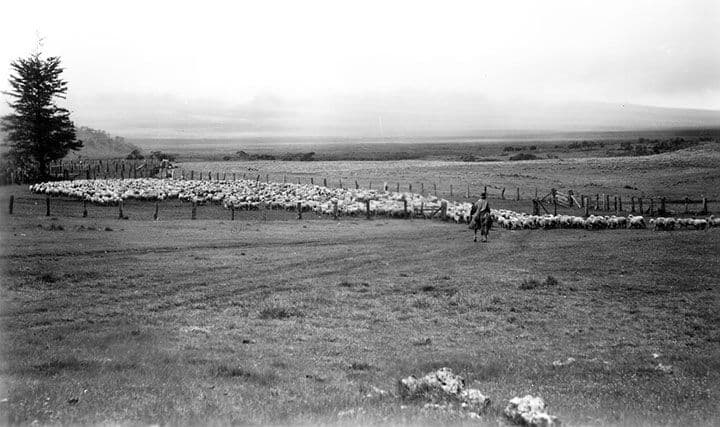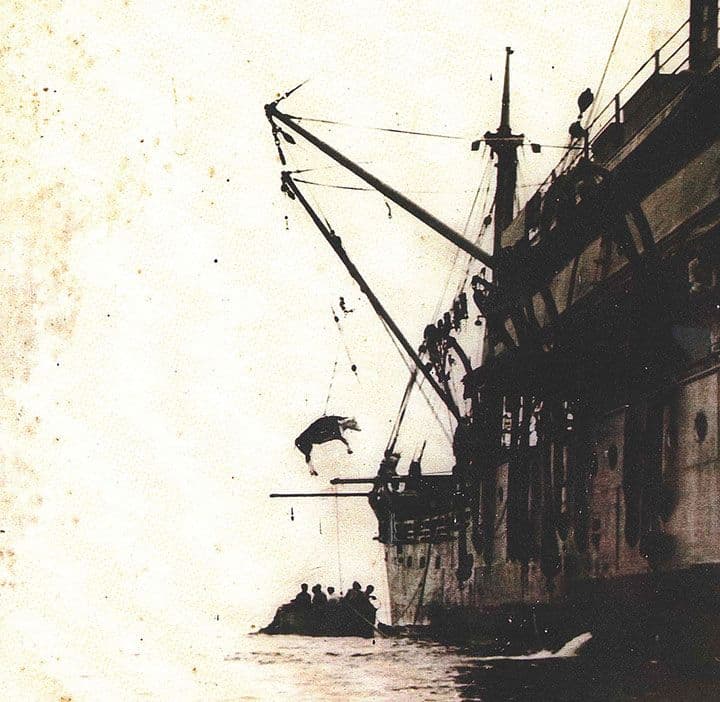By Hawaii.com Team

Photo courtesy of Paniolo Preservation Society.
Hawai‘i boasts its very own cowboy—the paniolo—who learned to rope and ride several decades before cowboys colored the plains of America’s “Wild West.” Their mark is found in upcountry Hawai‘i Island and Maui, where paniolo roam inland pasture and greened-over, volcanic cinder cones.
British Captain George Vancouver brought the first long-horned cattle to Hawai‘i in 1793 as a gift to King Kamehameha I. The grateful king placed a kapu (Hawaiian code of conduct)—carrying a death penalty—on their slaughter so they could multiply on Hawai‘i Island. Soon, there were enormous herds terrorizing everything in their path.
To contain the wild-eyed beasts, Hawaiian royalty summoned the seasoned cowboys of Old Mexico to the islands in 1832. The dashing vaqueros quickly taught Hawaiians how to tame the unruly bullocks. It’s thought the Hawaiian word paniolo originates from the Spanish word, español. These early island cattlemen are credited with supplying beef to the hordes of prospectors during California’s Gold Rush.

Photo courtesy of Paniolo Preservation Society.
Hawai‘i’s most famous paniolo is Ikua Purdy, who roped his way into history at the 1908 Frontier Days in Cheyenne, Wyoming. He wowed the West by securing his steer in 56 seconds flat—on a borrowed mount—and brought home the world championship. His feat is immortalized in a larger-than-life bronze at the Big Isle’s Parker Ranch Center in Waimea.
Born in Waimea, Purdy was the great-grandson of Kipikane, granddaughter of Kamehameha I and John Palmer Parker, founder of Parker Ranch—one of the largest, privately owned ranches in the U.S., Parker came to the Big Isle in 1809 as a 19-year-old sailor who jumped ship. He established Parker Ranch in 1847, which today sprawls 130,000 acres and runs 15,000 head of cattle.

Photo courtesy of Paniolo Preservation Society.
Parker’s original, Koa wood-lined home, Mana Hale, is open to visitors and displays authentic paniolo artifacts, including “shipping” saddles.
“These saddles were worn in the ocean to get cattle aboard transport ships,” details Nahua Guilloz of Parker Ranch. She says mounted paniolo accompanied swimming cattle, which were tethered to long boats, out to a waiting freighter in Kawaihae Harbor. A crane hoisted the animals up on the ship and Mana Hale has a photo to prove it.

Photo courtesy of Paniolo Preservation Society.
Mana Hale is free and open on weekdays at the Parker Ranch Headquarters. Visit www.parkerranch.com for more information on the establishment. The ranch’s historic Pukalani Stables is home to the new Paniolo Heritage Center. Also free, it’s open on Wednesdays during the Waimea Midweek Market and operated by the Paniolo Preservation Society (PPS).
The center houses the O‘ahu Cattleman Association’s Paniolo Hall of Fame; it chronicles the state’s growing list of standout ranchers and horsemen. Find Purdy’s hand-carved, leather hat and a 50-year collection of bits and spurs. For details on the lively monthly Paniolo Talk Story Nights, visit www.paniolopreservation.org/heritage-center.
For interactive paniolo fun, ride the range at Parker Ranch with Cowboys of Hawaii. History-themed horseback tours visit the stone corrals, where as many as 5,000 head of cattle were held after driven down from the slopes of Mauna Kea. The two-hour ride also visits the Red Track, where famous Parker Ranch thoroughbreds were trained and still hold world records for speed. Find out more at www.cowboysofhawaii.com.
Additionally, you can see paniolo in action on both the Big Island and Maui throughout the year. For instance, you can celebrate cowboy-style come July during the annual Independence Day rodeos. The Parker Ranch Horse Races and Rodeo is held at the Parker Ranch Rodeo Arena in Waimea. Call (808) 885-7311 for more information. And on Maui, there’s ropin’ and ridin’ at Oskie Rice Arena above Makawao. A colorful parade, featuring lei-bedecked paniolo and their mounts, winds through Makawao. The Hawaiian-style rodeo offers bull riding, rough stock events, rodeo clowns, live entertainment and country-western dancing. Call (808) 283-2741 for specific details on the event. Other island-bound rodeos inlcude the Parker Ranch Round-up in Waimea in September; the Panaewa Stampede every February in Hilo, (808) 937-1004; and the Kona Stampede in March, (808) 323-2388. Maui visitors can get their share of barrel racing and mugging at the Piiholo Classic Rodeo in September in Makawao as well as during the annual Memorial Day Rodeo at the Kaupakalua Roping Club Arena in Haiku. Visit www.ropemaui.com for details.
Speaking of Makawao—the town is a fun, artsy kind of locale where horses used to trot up and down Baldwin Avenue. You can still see their hitching posts fronting the Rodeo General Store. Nearby, lasso some paniolo duds and gear at Aloha Cowboy. Above town at Pi‘iholo Ranch, visitors can ride through pastures of cattle munching on billowing kikuyu and pangola grass, you can find out more at www.piiholo.com.
Further up the scenic slopes of Haleakala is ‘Ulupalakua Ranch; it’s privy to breathtaking views. Roaming over 18,000 acres, the ranch has 3,500 head of cattle. At the end of Highway 37, find the historic ranch store and Tedeschi Winery & Tasting Room. Serving the ranch since the 1800s, the store serves local beef and elk burgers. Outside are four, hand-carved statues by Reems Mitchell. Two depict legendary ‘Ulupalakua paniolo—the late Kauhi Purdy and Jimmy Hapakuka—and all make for great photo opps.
Since their inception in the 1830s, paniolo have contributed to Hawai‘i in many ways. Their popular traditions, like ki ho‘alu, (slack key guitar), hail from pastimes often enjoyed after a long day of work. And as paniolo of all ethnic descents used the Hawaiian language for ranch terminology (and still do today)—they are credited as “keepers of the Hawaiian language.”
Dr. Billy Bergin, PPS founder, adds, “From introducing methods of land and water conservation, to making advances in veterinary medicine, to spearing botanical surveys and agronomical improvements—paniolo have helped shape Hawai‘i history and the Hawaiian way of life.”
Join our newsletter for travel inspiration, insider tips and the latest island stories.
By subscribing, you agree to receive emails from Hawaii.com. You can unsubscribe anytime. See our Privacy Policy.